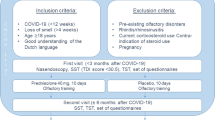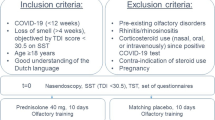Abstract
Background
Drug effects on the human sense of smell attract increasing interest, yet systematic evidence from controlled studies is sparse. The present cross-sectional approach to olfactory drug effects made use of the recent developments in informatics, knowledge discovery, and data mining allowing connecting drug-related information from humans with underlying molecular drug targets.
Methods
In this prospective cross-sectional study, n = 1008 outpatients at a general practitioner were enrolled. All currently taken medications were obtained, and olfactory function was assessed by means of a clinically established 12-item odor identification test. The association between the patients’ sense of smell and the administered medications was based (i) on the active pharmacological substances and (ii) on the molecular targets queried from the publicly accessible DrugBank database.
Results
Of the 168 different substances, six were taken sufficiently often to be analyzed. The administration of levothyroxine was associated with a higher olfactory score (p = 0.033). For the 168 drugs, 323 different targets could be queried. Thirty-one gene products were addressed sufficiently often to be analyzed. Besides agonistic targeting of thyroid hormone receptors (genes THRA1, THRB1) agreeing with the above result, antagonistically targeting the adrenoceptor alpha 1A (gene ADRA1A) by several unrelated medications was associated with a significantly higher olfactory score (p = 0.012).
Conclusions
The identified drug effects on olfaction are both biologically plausible based on supportive information from basic science studies. The novel molecular target-based approach suggested clear advantages over the classical drug or drug class-based approach. It increased the analyzable data volume fivefold and provided plausible hypotheses about mechanistic drug effects opening possibilities for drug discovery and repurposing.




Similar content being viewed by others
References
Lötsch J, Geisslinger G, Hummel T (2012) Sniffing out pharmacology: interactions of drugs with human olfaction. Trends Pharmacol Sci 33(4):193–9
Damm M, Temmel A, Welge-Lüssen A, Eckel HE, Kreft MP, Klussmann JP et al (2004) Epidemiologie und Therapie von Riechstörungen in Deutschland, Österreich und der Schweiz. HNO 52:112–20
Hummel T, Nordin S (2005) Olfactory disorders and their consequences for quality of life. Acta Otolaryngol 125(2):116–21
Rinaldi A (2007) The scent of life. The exquisite complexity of the sense of smell in animals and humans. EMBO Rep 8(7):629–33
Croy I, Nordin S, Hummel T (2014) Olfactory disorders and quality of life—an updated review. Chem Senses 39(3):185–94
Birkett D, Brosen K, Cascorbi I, Gustafsson LL, Maxwell S, Rago L et al (2010) Clinical pharmacology in research, teaching and health care: considerations by IUPHAR, the International Union of Basic and Clinical Pharmacology. Basic Clin Pharmacol Toxicol 107(1):531–59
Henkin RI (1994) Drug-induced taste and smell disorders. Incidence, mechanisms and management related primarily to treatment of sensory receptor dysfunction. Drug Saf Int J Med Toxicol Drug Exp 11(5):318–77
Tuccori M, Lapi F, Testi A, Ruggiero E, Moretti U, Vannacci A et al (2011) Drug-induced taste and smell alterations: a case/non-case evaluation of an Italian database of spontaneous adverse drug reaction reporting. Drug Saf 34(10):849–59
Fröhlich R (1851) Ueber einige modificationen des geruchsinnes. Akad Wiss Wien Math Nat 6:322–8
Lötsch J, Darimont J, Skarke C, Zimmermann M, Hummel T, Geisslinger G (2001) Effects of the opioid remifentanil on olfactory function in healthy volunteers. Life Sci 69(19):2279–85
Oertel BG, Huynh TT, Hummel T, Lötsch J (2014) Lack of fluconazole effects on human chemosensation. Int J Clin Pharmacol Ther
Walter C, Oertel BG, Ludyga D, Ultsch A, Hummel T, Lötsch J (2014) Effects of 20 mg oral Delta-tetrahydrocannabinol on the olfactory function of healthy volunteers. Br J Clin Pharmacol
Czesnik D, Schild D, Kuduz J, Manzini I (2007) Cannabinoid action in the olfactory epithelium. Proc Natl Acad Sci U S A 104(8):2967–72
Gudziol V, Hummel C, Negoias S, Ishimaru T, Hummel T (2007) Lateralized differences in olfactory function. Laryngoscope 117(5):808–11
Hummel T, Sekinger B, Wolf SR, Pauli E, Kobal G (1997) ‘Sniffin’ Sticks’: olfactory performance assessed by the combined testing of odor identification, odor discrimination and olfactory threshold. Chem Senses 22(1):39–52
Kobal G, Hummel T, Sekinger B, Barz S, Roscher S, Wolf SR (1996) “Sniffin’ Sticks”: screening of olfactory performance. Rhinology 34:222–6
Rosenbaum PR, Rubin DB (1983) The central role of the propensity score in observational studies for causal effects. Biometrika 70(1):41–55
Law V, Knox C, Djoumbou Y, Jewison T, Guo AC, Liu Y et al (2014) DrugBank 4.0: shedding new light on drug metabolism. Nucleic Acids Res 42:D1091–7, Database issue
Huang DW, Sherman BT, Lempicki RA (2009) Systematic and integrative analysis of large gene lists using DAVID bioinformatics resources. Nat Protoc 4(1):44–57
Jójárt G (1992) Sense of smell after gentamicin nose-drops. Lancet 339(8788):313
McConnell RJ, Menendez CE, Smith FR, Henkin RI, Rivlin RS (1975) Defects of taste and smell in patients with hypothyroidism. Am J Med 59(3):354–64
Grossman S (1953) Loss of taste and smell due to propylthiouracil therapy. N Y State J Med 53(10):1236
Alexander C, Bader JB, Schaefer A, Finke C, Kirsch CM (1998) Intermediate and long-term side effects of high-dose radioiodine therapy for thyroid carcinoma. J Nucl Med 39(9):1551–4
Dhong H-J, Kim HY, Ha BS (2003) Histologic changes to olfactory epithelium in hypothyroid rats. Otolaryngol Head Neck Surg 129(1):24–32
Beard MD, Mackay-Sim A (1987) Loss of sense of smell in adult, hypothyroid mice. Brain Res 433(2):181–9
Johanson IB (1980) Development of olfactory and thermal responsiveness in hypothyroid and hyperthyroid rat pups. Dev Psychobiol 13(3):343–41
Paternostro M, Meisami E (1989) Selective effects of thyroid hormonal deprivation on growth and development of olfactory receptor sheet during the early postnatal period: a morphometric and cell count study in the rat. Int J Dev Neurosci 7(3):243–55
Hoyk Z, Szilágyi T, Halász N (1996) Modulation by thyroid hormones of the development of external plexiform layer in the rat olfactory bulb. Neurobiology (Bp) 4(1–2):45–57
Zhang L, Blomgren K, Kuhn HG, Cooper-Kuhn CM (2009) Effects of postnatal thyroid hormone deficiency on neurogenesis in the juvenile and adult rat. Neurobiol Dis 34(2):366–74
Walczak M, Pruszewicz A, Łacka K, Karlik M (2002) Olfaction in congenital hypothyroidism. Otolaryngol Pol 56(5):577–81
Zimnik NC, Treadway T, Smith RS, Araneda RC (2013) α(1A)-Adrenergic regulation of inhibition in the olfactory bulb. J Physiol 591(Pt 7):1631–43
Araneda RC, Firestein S (2006) Adrenergic enhancement of inhibitory transmission in the accessory olfactory bulb. J Neurosci 26(12):3292–8
Nai Q, Dong HW, Linster C, Ennis M (2010) Activation of alpha1 and alpha2 noradrenergic receptors exert opposing effects on excitability of main olfactory bulb granule cells. Neuroscience 169(2):882–92
Young TM, Mathias CJ (2004) Taste and smell disturbance with the alpha-adrenoceptor agonist midodrine. Ann Pharmacother 38(11):1868–70
Mandairon N, Peace S, Karnow A, Kim J, Ennis M, Linster C (2008) Noradrenergic modulation in the olfactory bulb influences spontaneous and reward-motivated discrimination, but not the formation of habituation memory. Eur J Neurosci 27(5):1210–9
Gudziol V, Lötsch J, Hahner A, Zahnert T, Hummel T (2006) Clinical significance of results from olfactory testing. Laryngoscope 116(10):1858–63
Doty RL, Deems DA, Stellar S (1988) Olfactory dysfunction in parkinsonism: a general deficit unrelated to neurologic signs, disease stage, or disease duration. Neurology 38(8):1237–44
Barz S, Hummel T, Kobal G (1997) Olfactory function in treated and untreated patients with Parkinson’s disease. Neurology 49(5):1424–31
Lötsch J, Geisslinger G (2010) Bedside-to-bench pharmacology: a complementary concept to translational pharmacology. Clin Pharmacol Ther 87(6):647–9
Lötsch J, Hummel T (2015) Cannabinoid-related olfactory neuroscience in mice and humans. Chem Senses 40(1):3–5
Seal RL, Gordon SM, Lush MJ, Wright MW, Bruford EA (2011) genenames.org: the HGNC resources in 2011. Nucleic Acids Res 39:D514–9, Database issue
Funding
The research received funding from the “Landesoffensive zur Entwicklung wissenschaftlich-ökonomischer Exzellenz: LOEWE-Schwerpunkt: Anwendungsorientierte Arzneimittelforschung” (JL). The funders had no role in method design, data selection and analysis, decision to publish, or preparation of the manuscript.
Conflicts of interest
The authors have declared that no competing interests exist.
Author information
Authors and Affiliations
Corresponding author
Additional information
Alfred Ultsch and Thomas Hummel contributed equally to this work.
Rights and permissions
About this article
Cite this article
Lötsch, J., Daiker, H., Hähner, A. et al. Drug-target based cross-sectional analysis of olfactory drug effects. Eur J Clin Pharmacol 71, 461–471 (2015). https://doi.org/10.1007/s00228-015-1814-2
Received:
Accepted:
Published:
Issue Date:
DOI: https://doi.org/10.1007/s00228-015-1814-2




